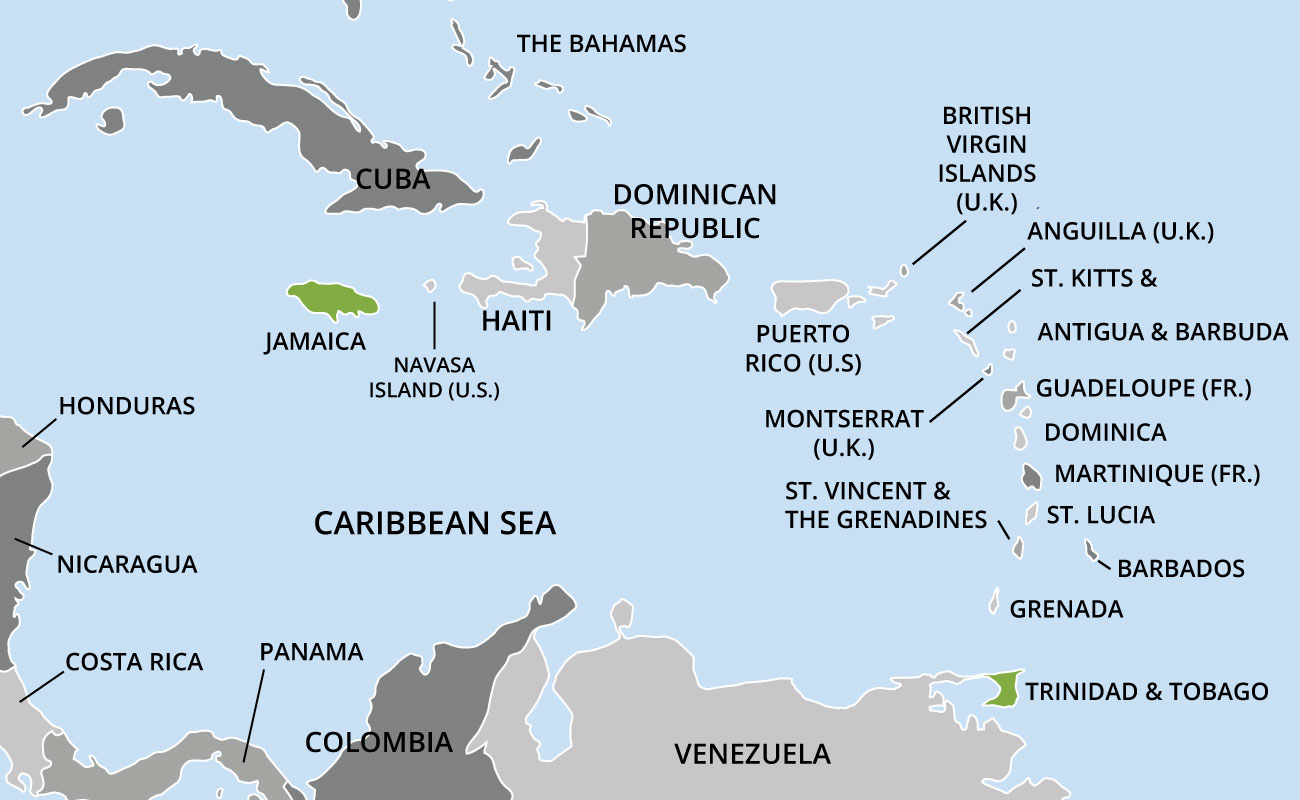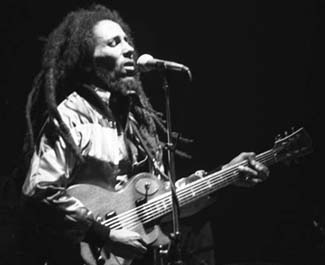
Jamaica, Trinidad and Tobago
Known as a tourist destination in the sunny Caribbean, Jamaica is associated with reggae, a musical style that emerged in the late 1960s. The sequels of the slave trade are apparent in the unequal distribution of the country's resources, and the subsequent violence that residents of the slums of Kingston, the capital city, are subjected to. As in the rest of the Caribbean, the music of Jamaica is a tributary of the African origin of the majority of the population, and it shows a great deal of diversity and continuity due to its colonial past.
Among the many styles such as "mento", "maypole dance", "quadrille" and the "Revival music" that emerged in the past centuries, this chapter will cover the music of Kumina, the roots of the Rastafarian genres of the contemporary scene.
Kumina is preserved among the "maroons" who escaped to the mountains of Jamaica during slavery in the 17th and 18th centuries. "Maroon" is a French term that means wild, and the people known as maroons consisted of Karomanti from Ghana in West Africa, or Kromanti as they are called in Jamaica, who did not take well to the regime of the plantation. Similar to Cacique Henri (Arawak leader) of Saint Domingue in the 1620s, and "Zumbi" (African warrior) of Northeastern Brazil in the 1600s, the Jamaican maroons resisted slavery by pursuing guerilla tactics which consisted of harassing the plantations located in the plains below.
They were so successful that the British government had to sue for peace in the 1730s, and a treaty was signed granting them land and autonomy. These fierce people resisted the government forced assimilation on the rural population of the island in favor of their way of life. Today, their descendants are to be found in four major communities: Accompong, in the Cockpit, a rugged mountain area in the western part of the island, and the Blue Mountains villages of Moore Town, Charles Town and Scott's Hall in the eastern region.
Kumina today, like the Vodou of Haiti and other African derived traditions in the Americas, is an amalgamation of styles of many of the ethnic groups brought to Jamaica. For an understanding of the modern musical scene, one has to go back to the emergence of the Kongo styles as a powerful force in Caribbean music.
In an article on "Revival Cults in Jamaica", Edward Seaga contends that the Afro-Christian rituals known as "Poccomania", which many folklorist have translated as "a little madness", should instead be spelled "Pukkumina" to refer to its African origin. Kumina is practiced primarily in the eastern regions of the island, and shows strong retentions of the Bantu-speaking people of the Kongo Angola region of West Africa. A danced religion, it incorporates a variety of musical and dance styles throughout Jamaica, the common denominator being spirit possession. The main focus of possession, that some Caribbean scholars (Marc Chrisophe in particular) associated with KOSANBA (The Congress of Santa Barbara, a scholarly association for the study of Vodou, founded in 1997 in Santa Barbara, CA) insist should be called "epiphany", is communication for community healing. Through music and dancing, the community renews its link with the ancestors and affirms its identity.
The roots of reggae are to be found in Rastafarism through Kumina and its variants. It was the dimension of community healing, cultural affirmation, and resistance that appealed to the rural poor and the young people living in the depressed areas of Kingston. Rastafarism, which goes back to the heart of maroon resistance, is also linked to Garveyism, a Pan-African self-help movement of the 1920s, which advocated a return to Africa.
![]() PSALM 68
PSALM 68
Princes shall come out of Egypt; Ethiopia shall soon stretch out her hands unto God.![]()
Marcus Garvey, inspired by this Bible passage, predicted the rise of Africa from colonialism when a black king will be crowned and come to redeem the people.
When Haile Selassie was made Emperor of Ethiopia in 1930 and took the name Ras Tafari Makonnen, the downtrodden of Jamaica took it as a sign that the prophecy of deliverance had been fulfilled. Rastafarism emerged over time as a coherent socio-cultural movement with a message of deliverance, resistance and aspirations to social justice.
Three major tendencies, known as "Mansions of Rastafari" may be identified:
- "Bobo Ashanti"
- "the Twelve Tribes of Israel"
- "Nyabinghi"
The chants of Nyabinghi (an early 20th century resistance movement against colonialism in Uganda, Africa) influenced the popular ska, rocksteady, and of course reggae, a fusion of mento, calypso, and R&B.
The drumming of Nyabinghi consists of the traditional three drum chorus. These drums, known as "harps", are the "bass", the middle-pitched "funde", and the "akete", or "repeater", which plays a series of improvised cross-rhythms. The funde plays a regular one-two pattern, while the bass accentuates the first beat of the 4/4 measure. This style of drumming, which is common to all Rastafarians, became the basis of the heavy bass driven form characteristic of reggae, a music in which the melody is transferred to the bass.
Composer: Accompong Maroons
-
"Nyabinghi"
Reggae emerged as one of the most powerful mediums of Pan-African resistance in the 1970s. Its social message and music are adopted in black communities around the world, particularly by youth who aspire to justice and peace.
In this regard, Bob Marley's "Redemption Song" summarizes the epic struggle and history of black resistance and affirmation, not only in Jamaica, but in Africa, America, and the Islands of the seas.
Composer: 0
-
"Redemption Song"
Composer: 0
-
"Three Little Birds"
The international appeal of reggae accounts for its success as a musical genre. With spiritual roots in West Africa reggae incubated in the maroon communities of Jamaica and the slums of the Caribbean, and returned to fertilize the cultural productions of the motherland.





Rara bands hold ceremonies to ask the spirits to protect them and their instruments on the spiritually dangerous streets.







